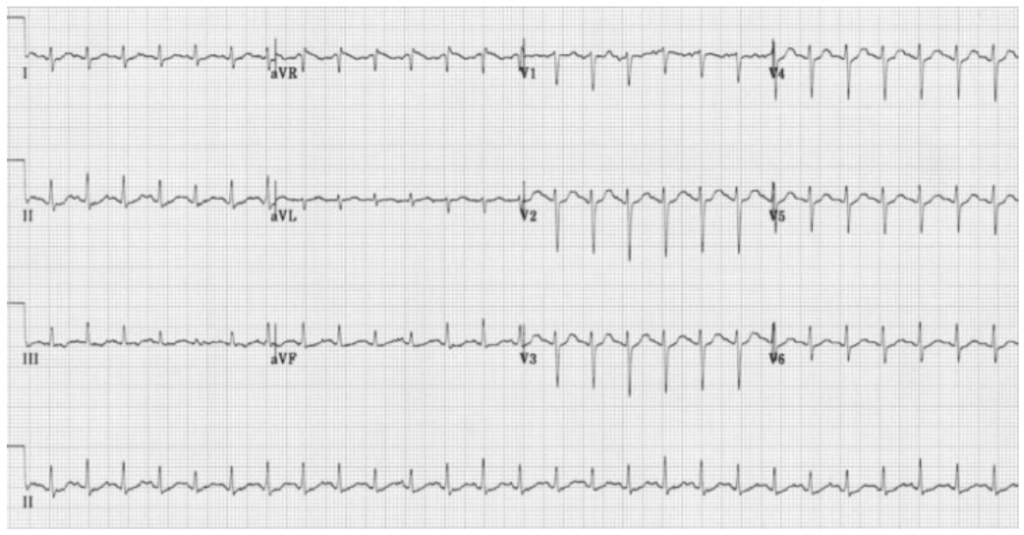About Sinus Tachycardia
Sinus Tachycardia (ST) is a regular heart rhythm where the heart rate increases and therefore increases cardiac output. It is normal under periods of exertion (such as exercise) for the heart rate to increase, however with sinus tachycardia, the heart rate increases while the patient is at rest and may be present for a prolonged period of time.
For adults, resting heart rates are between 60-100 beats per minute, if the heart rate is above 100 beats per minute, a sinus tachycardia may be considered. In children, normal heart rates are usually between 100-150 depending on the age of the child.
Sinus tachycardia may have a number of pathological or physiological causes and may also be referred to as Supraventricular Tachycardia (SVT).1

Causes of Sinus Tachycardia
There can be many and varied causes for an increase in heart rate and some will be considered normal and should return to a normal rate (< 100 beats per minute) after a period of rest. However, some may require immediate medical intervention.
Neurohormonal causes:
It may be considered normal to have an accelerated heart rate whilst under duress or during exercise where hormones, such as adrenaline, are released during these periods and can cause the heart rate to increase. This can also occur during periods of high anxiety, panic or fear. Additionally, over-stimulation of naturally occurring hormones such as thyroxine in the case of an overactive thyroid gland may also cause sinus tachycardia to occur.
Cardiac causes:
Supraventricular Tachycardias (SVT) or rhythms originating above the ventricle are the most common cardiac cause. These rhythms may be classified as regular or irregular and lead to a possible diagnosis. Irregular heart rates can indicate Atrial Fibrillation or if a regular heart rate is present, Atrial Flutter. Atrioventricular nodal re-entrant tachycardia (AVNRT) may also be considered as a cause of ST.
Other cardiac causes include Myocarditis due to inflammation of the myocardium which is usually in response to a viral illness. Myocardial Infarction (MI), also known as a heart attack, or any acute coronary event that leads to an increase in the heart rate due to myocardial injury or low blood pressure can also be a cause. As well as, Hypovolaemia which is when decreased circulating blood (of any cause) leads to an increased heart rate to compensate for a reduced circulating blood volume.
Non Cardiac causes:
A Pulmonary Embolus (PE) is a blood clot that can sit within the pulmonary circulation and has the potential to lead patients to become short of breath, due to an oxygen deficit or hypoxia and the heart rate may increase in order to compensate for this reaction.
Other non-cardiac related causes include sepsis which refers to systemic infection of any cause and shock from any cause resulting in an increased heart rate in order to maintain adequate blood pressure.
In some clinical situations, that have been outlined in the Causes of ST, patients may require full medical resuscitation and be considered a medical emergency.2
Additionally, drug ingestion can also be a non-cardiac related cause. This might include but is not limited to:
- Alcohol,
- Amphetamines,
- Antihistamines,
- Ventolin / salbutamol,
- Opioids,
- Caffeine,
- Tobacco,
- Cocaine, and
- Caffeinated drinks (such as energy drinks).
Symptoms of Sinus Tachycardia (ST):
Most patients with sinus tachycardia may not present with any symptoms, however, if symptoms are present they may include:
- Palpitations,
- Shortness of breath,
- “Racing” feeling in the chest,
- Sweating,
- Anxious,
- Chest pain,
- Syncope / dizziness,
- Low blood pressure (hypotension).3
Treatment of Sinus Tachycardia
The treatment of sinus tachycardia is typically centred around the trigger for the episodes to occur:
- In the instance of substance stimulation, such as caffeine, reducing the intake of the substance if possible
- In the instance of prescription medication, attempting to see if an alternative treatment option is available or restricting the dose administered if possible
- Anxiety-related causes require the patient to learn and attempt relaxation techniques such as deep breathing exercises
- In the event of an unknown cause, medications such as beta-blockers to help reduce the heart rate may be appropriate
- Instigation of a Valsalva manoeuver may also be used to attempt to slow down the heart rate, however, the success may vary depending on the underlying rhythm
Modified Valsalva manoeuvre for supraventricular tachycardia
*All content on Hope For Hearts does not endorse or promote any brands or devices and is only intended for educational purposes. Patients should always consult individual health matters with a medical professional.
Vasovagal techniques aim to slow the bodies autonomic system by slowing the electrical conduction through the AV node, and hopefully ending the rapid heart rate. There are multiple techniques used to perform this manoeuvre, that is only used after the patient has been assessed and deemed clinically stable, as in their blood pressure is considered normal.
